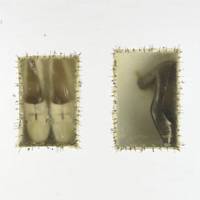Monday, November 08, 2004
Treat the Work with Some Respect, Please
An interview with the artist conducted by Marguerite Feitlowitz provides a good description of works from the series.
Salcedo’s work functions as both art and memorial. Looking at these shoes (shoes either found at mass grave sites or donated by relatives of the disappeared) raises strong feelings—feelings that neither art nor large-scale memorials typically raise on their own.MF: Shoes are a dominant element in the series you call Atrabiliarios, an archaic Spanish word whose Latin roots, atra bilis, combine profound mourning with bile, or rage. You 'buried' the shoes, many of which lack their mate, in wall niches, which you then covered with translucent animal fiber and closed with surgical thread. The process itself, one of humble care and profound homage, calls up ancient customs; the effect on the viewer is one of searing loss. The shoes are at once homely and familiar, but because they are sealed off and their outlines are indistinct, they seem to be fading before our eyes into another realm.
DS: It is more and more difficult to find the diffuse boundary between the intimate and the political. The grief of the relatives of desaparecidos—like all grief—is of an intimate nature, but when the essence of these events is political, I believe the society must acknowledge it. I am interested in showing that social injury, its collective character.
This week Sotheby’s will be selling a small work from the series while Phillips offers a larger piece. Here are the catalogue photos of both. The Sotheby’s piece is on the left.


These two pieces, sadly, provide case studies for collectors who buy works at auction. They demonstrate why it’s crucial to examine any piece in person rather than relying on a catalogue photo and an auction house condition report.
I had looked at the Sotheby’s photo a couple times last week without noticing an important detail that I saw right away when inspecting the piece at the preview last weekend. The sutures on the left niche are broken. Someone, at some point along the way, put a hand through the animal skin and tore it away from the mounting.
I was surprised by the extent of damage to the piece and by the fact that the owner would put such a compromised work up for sale. Curious about how the auction house was dealing with the situation, I asked a specialist for the condition report on the piece. The condition Sotheby’s was reporting: “generally good.” Judge for yourself. Here are some close-up shots of the damage. (Click on the photos for enlargements.)


The work for sale at Phillips also has serious condition problems. It appears that the owner of the work decided, at some point, to repaint the wall in which the work was mounted. Here are the results.

While the damage here is not as extensive as that done to the work at Sotheby’s, this piece may actually prove more difficult to restore. Because it has been painted, the original surgical thread has lost its integrity and cannot be reused, and the organic material will need to be treated with a chemical solvent to remove the paint that now mars it.
I was disappointed to see the damage suffered by both these works and the lack of care given to them by their owners. Works of art—especially powerful works of memorial art like these—deserve to be treated much better.